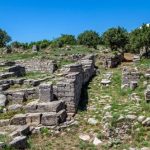 Weird Stuff
Weird Stuff  Weird Stuff
Weird Stuff  Our World
Our World 10 Ways Your Christmas Tree Is More Lit Than You Think
 Movies and TV
Movies and TV The 10 Coolest Stars to Set Sail on The Love Boat
 History
History 10 Things You Didn’t Know About the American National Anthem
 Technology
Technology Top 10 Everyday Tech Buzzwords That Hide a Darker Past
 Humans
Humans 10 Everyday Human Behaviors That Are Actually Survival Instincts
 Animals
Animals 10 Animals That Humiliated and Harmed Historical Leaders
 History
History 10 Most Influential Protests in Modern History
 Creepy
Creepy 10 More Representations of Death from Myth, Legend, and Folktale
 Technology
Technology 10 Scientific Breakthroughs of 2025 That’ll Change Everything
 Weird Stuff
Weird Stuff Ten Bizarre Facts About The Doge Meme
 Our World
Our World 10 Ways Your Christmas Tree Is More Lit Than You Think
 Movies and TV
Movies and TV The 10 Coolest Stars to Set Sail on The Love Boat
Who's Behind Listverse?

Jamie Frater
Head Editor
Jamie founded Listverse due to an insatiable desire to share fascinating, obscure, and bizarre facts. He has been a guest speaker on numerous national radio and television stations and is a five time published author.
More About Us History
History 10 Things You Didn’t Know About the American National Anthem
 Technology
Technology Top 10 Everyday Tech Buzzwords That Hide a Darker Past
 Humans
Humans 10 Everyday Human Behaviors That Are Actually Survival Instincts
 Animals
Animals 10 Animals That Humiliated and Harmed Historical Leaders
 History
History 10 Most Influential Protests in Modern History
 Creepy
Creepy 10 More Representations of Death from Myth, Legend, and Folktale
 Technology
Technology 10 Scientific Breakthroughs of 2025 That’ll Change Everything
10 Modern Cities That Are Actually Built on Ancient Ruins
Modern cities captivate us with their gleaming skyscrapers, bustling streets, and contemporary conveniences. Yet, beneath the veneer of 21st-century life, many of these cities are built on foundations of ancient ruins, places that once thrived with the civilizations that came before. Visiting these cities offers an extraordinary experience: a unique blend of modernity resting atop layers of history, where each site serves as a gateway to the past.
From the temples of the Aztecs hidden under Mexico City’s bustling avenues to the remnants of the mighty Roman Empire beneath Rome’s city streets, these cities remind us that history is never far away. Their ancient ruins not only add to their allure but also provide a cultural and historical depth that continues to shape their identities. Here are ten cities around the world that merge ancient ruins with modern life, each offering a profound journey back through time.
Related: 10 Significant Biblical Archaeology Discoveries
10 Lima, Peru
Lima, the capital and cultural hub of Peru, combines the features of a modern metropolis with a deep-rooted history. This bustling city, home to nearly a third of Peru’s population, is a vibrant center for commerce, industry, and transportation. Its infrastructure includes Peru’s largest airport, extensive sports venues, and a state-of-the-art light rail system. Despite Lima’s modern skyline, the city’s past stretches back to the time of the Incas, who established settlements in the region around AD 1400. Much of these early Inca sites lay forgotten, buried beneath centuries of urban expansion.
In the 1950s, significant archaeological work unearthed remnants of Lima’s ancient heritage, bringing the city’s hidden history to light. Among the most remarkable sites is Huaca Huallamarca, a pre-Columbian adobe pyramid standing as a testament to Lima’s ancient roots. Located in the city’s heart, this ancient structure provides a stark contrast to Lima’s contemporary urban landscape. Huaca Huallamarca, now a well-preserved historical site, offers both locals and tourists a glimpse into the city’s distant past. These ruins serve as a powerful reminder that Lima, while modernized, rests upon layers of history dating back to the Incas and beyond.[1]
9 Mexico City, Mexico
Mexico City, the largest urban center in North America, is a bustling metropolis with a rich historical tapestry woven directly into its foundation. Known as the oldest capital city in the Americas, Mexico City was originally Tenochtitlán, the thriving capital of the Aztec Empire. Today, remnants of this ancient civilization are interwoven throughout the modern cityscape. The Templo Mayor, once a major Aztec temple, stands as a testament to the city’s indigenous roots, revealing the Aztec’s architectural prowess and spiritual legacy.
Further evidence of ancient life lies at the Cholula Archaeological Zone, where visitors can view remnants of the world’s largest pyramid, even surpassing the size of Egypt’s Great Pyramid. Although the Cholula pyramid now appears as a natural hill topped by a colonial church, excavations reveal an extensive labyrinth of tunnels beneath. These historical layers tell the story of Mexico City’s evolution from an indigenous stronghold to a thriving modern capital, where bustling avenues and towering skyscrapers coexist with sacred Aztec sites, creating a uniquely layered cultural experience.[2]
8 Rome, Italy
Rome, often referred to as the “Eternal City,” seamlessly merges modern vibrancy with a legacy that spans nearly three millennia. Founded in 753 BC, Rome has been continuously inhabited for centuries, making it one of the oldest cities in Europe. The grandeur of ancient Rome remains evident in iconic structures such as the Colosseum, a massive arena that hosted gladiator contests and public spectacles nearly 2,000 years ago. While walking through the Roman Forum, visitors encounter relics from the time of Julius Caesar and Augustus, showcasing the city’s central role in shaping Western civilization.
Today, approximately 90% of ancient Rome lies buried beneath the city’s contemporary streets, with only a small fraction visible. The Pantheon, a marvel of ancient engineering with its massive dome, offers insight into Rome’s architectural achievements, while the Castel Sant’Angelo, originally built as a mausoleum, reflects the city’s evolving use of space over the centuries. Rome’s mix of ancient and modern life—from bustling marketplaces to centuries-old ruins—creates a uniquely immersive experience, drawing visitors eager to walk in the footsteps of emperors and artists.[3]
7 Istanbul, Turkey
Istanbul, Turkey’s cultural and economic heart, has a rich history that reflects its strategic position between Europe and Asia. Originally known as Byzantium, the city became Constantinople under Roman rule and served as the Eastern Roman Empire’s capital. Later, the city transitioned into Ottoman rule, further enhancing its architectural and cultural diversity. Istanbul’s ancient roots are visible, but discovering its historical remnants requires a bit of exploration. Beneath its modern structures lie traces of empires past, creating a unique blend of old and new.
Among Istanbul’s most notable ancient sites is the Basilica Cistern, a subterranean marvel built by Emperor Justinian in the 6th century. After descending into its cavernous chamber, visitors are met with dimly lit columns and echoing splashes of water, creating an atmosphere that feels timeless. The Column of Constantine and the Valens Aqueduct further attest to the city’s Roman and Byzantine heritage, while the Hippodrome marks Istanbul’s legacy of public gatherings and ceremonies. These ancient sites, woven into the modern landscape, serve as reminders of Istanbul’s historical significance and enduring legacy.[4]
6 Madurai, India
Madurai, one of India’s oldest cities, rests on the banks of the River Vaigai in the state of Tamil Nadu. Known as the “city that never sleeps,” Madurai has a history that spans over 2,500 years, making it a significant cultural and religious center. Today, it serves as Tamil Nadu’s cultural capital, blending ancient traditions with a thriving modern urban life. Madurai’s vibrant temples and bustling markets reflect its historical importance, while its contemporary infrastructure supports a rapidly growing population.
Madurai is home to the Tirumalai Nayakkar Palace, a testament to the architectural achievements of the Nayak dynasty, built in 1638. Throughout the city, remnants of ancient settlements and temples showcase the influence of various rulers over the centuries. Each monument reflects the city’s artistic heritage, from intricate carvings to grand temple complexes. Madurai’s harmonious blend of ancient ruins and modern city life offers a profound journey into the region’s historical roots, drawing pilgrims and tourists alike.[5]
5 Xi’an, China
Xi’an, a city with a history stretching back over 3,000 years, stands as a living reminder of China’s ancient heritage. Known as one of the country’s four great ancient capitals, Xi’an was the eastern starting point of the Silk Road, connecting China to the rest of the world. Today, it is one of the most popular tourist destinations in China, attracting millions each year to witness its ancient wonders. Xi’an’s importance as a historical center is embodied in the ancient city walls that still encircle its old town, offering glimpses into the city’s military and architectural past.
The Terracotta Army, Xi’an’s most famous attraction, was discovered in 1974, unveiling thousands of life-sized clay soldiers crafted over two millennia ago to guard Emperor Qin Shi Huang’s tomb. Each soldier, unique in expression and armor, reflects the artistry and complexity of the Qin Dynasty. This UNESCO World Heritage Site, along with other preserved monuments, provides visitors with an immersive experience, blending the grandeur of ancient dynasties with Xi’an’s bustling modern streets.[6]
4 Kyoto, Japan
Kyoto, once the imperial capital of Japan, serves as a gateway to the country’s rich history and traditional culture. Founded in 794 as Heian-kyō, Kyoto was Japan’s capital for over 1,000 years and remains a significant cultural and spiritual hub. Today, Kyoto is a modern city with bustling districts, yet its ancient shrines, temples, and gardens evoke a timeless atmosphere. The city’s historic architecture, well-preserved due to its exemption from WWII bombings, attracts millions of visitors each year.
Among Kyoto’s ancient sites are the Oeyama Historic Tomb and the Uenoyama Tumulus, which date back centuries and serve as silent witnesses to Japan’s distant past. Visitors to Kyoto often explore the Kiyomizu-Dera Temple and Fushimi Inari Shrine, known for their iconic red torii gates. These ancient structures offer an escape into Japan’s spiritual heritage, where Kyoto’s modernity blends seamlessly with its historical reverence, creating a peaceful retreat amid Japan’s bustling urban landscape.[7]
3 Athens, Greece
Athens, the birthplace of democracy, is a city where ancient and modern life coexist harmoniously. Founded over 5,000 years ago, Athens has continuously evolved, yet it remains deeply connected to its ancient past. Walking through Athens, one can see the mighty Parthenon rising atop the Acropolis, a powerful symbol of ancient Greek civilization and architectural ingenuity. Temples, plazas, and ancient theaters scattered throughout the city tell stories of philosophers like Plato and Socrates, who once walked these same streets.
Beyond the Acropolis, notable sites like the Temple of Olympian Zeus and the Erechtheion showcase Athens’ historical grandeur. While Athens is a bustling modern capital, these ancient landmarks remain central to its identity, attracting visitors eager to explore its cultural and historical legacy. Athens exemplifies the balance between a dynamic contemporary city and a place steeped in mythology, philosophy, and history, offering an inspiring journey through the foundations of Western civilization.[8]
2 Barcelona, Spain
Barcelona, a city famous for its distinct Catalonian culture and iconic modernist architecture, is also deeply rooted in Roman history. Originally established as a Roman military colony known as Barcino, Barcelona’s ancient past still resonates through its historic architecture and subterranean ruins. Within the Barcelona City History Museum, visitors can descend into the remains of ancient Roman streets and buildings, viewing artifacts like mosaic floors, wine-making facilities, and even ancient fish-salting factories. These remnants reveal aspects of daily life during Roman rule, connecting visitors with Barcelona’s ancient origins amidst the city’s contemporary buzz.
Beyond the museum, the towering Temple of Augustus offers a striking connection to Barcelona’s Roman legacy. Built during the first century BC, this temple once stood at the heart of Roman Barcino and was dedicated to the emperor Augustus. Although much of it is gone, the temple’s remaining columns stand as silent witnesses to Barcelona’s early history. The city’s rich Roman heritage, harmoniously blended with modern architecture, provides a fascinating experience where ancient walls coexist with the vibrant pulse of a modern European metropolis. This fusion of past and present makes Barcelona a unique destination, drawing millions who seek to explore its layered history and cultural depth.[9]
1 Cairo, Egypt
Cairo, the largest city in the Arab world, is a bustling metropolis steeped in the ancient history of Egypt. Known as the gateway to some of humanity’s earliest civilizations, Cairo lies just a few miles from the iconic Giza Plateau, where the Pyramids of Giza and the Great Sphinx stand as eternal symbols of Egypt’s grandeur. These ancient monuments, dating back over 4,500 years, offer a tangible link to Egypt’s Old Kingdom and the age of the pharaohs. Beyond the pyramids, Cairo’s streets teem with vibrant bazaars, historic mosques, and bustling markets that capture the city’s unique blend of ancient and modern life.
The Egyptian Museum, located in the heart of Cairo, houses an unparalleled collection of antiquities, including treasures from King Tutankhamun’s tomb and relics spanning thousands of years of Egyptian history. In recent years, the Grand Egyptian Museum near Giza promises to offer an even more extensive exploration of Egypt’s storied past. The proximity of Cairo’s modern infrastructure to these ancient wonders draws millions of visitors each year, eager to uncover Egypt’s mysteries and experience its living history. Cairo’s dynamic blend of ancient artifacts and vibrant modern culture provides a profound journey into the heart of one of the world’s most enduring civilizations.[10]








